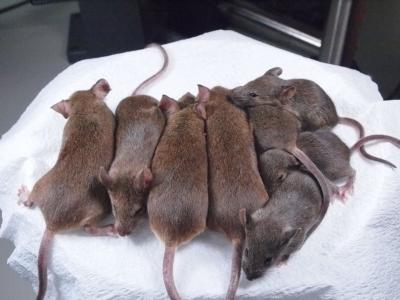Immortal Line of Cloned Mice Created

Watch out, George Lucas, there's a new attack of the clones, and these ones are furry.
Japanese researchers have created a potentially endless line of mice cloned from other cloned mice. They used the same technique that created Dolly the sheep to produce 581 mice from an original donor mouse through 25 rounds of cloning, the scientists report in the March 7 issue of the journal Cell Stem Cell.
"This technique could be very useful for the large-scale production of superior-quality animals, for farming or conservation purposes," study leader Teruhiko Wakayama of the RIKEN Center for Developmental Biology in Kobe, Japan, said in a statement.
The researchers used a cloning technique called somatic cell nuclear transfer, in which a cell nucleus containing one individual's genetic information is inserted into an egg cell whose nucleus has been removed. Dolly the Sheep became the first cloned mammal in 1996 using this technique. Many other animals have been cloned since, but the technique has had a low success rate and attempts to "reclone" animals have often failed.
Genetic abnormalities that can accumulate over consecutive generations of clones may explain these failures, Wakayama said. [That's Odd! The 10 Weirdest Animal Discoveries]
In their study, Wakayama and colleagues grew the cloned cells in a solution containing trichostatin, a compound that interferes with enzymes that make changes to DNA. Using this technique, the cloning process was five times more successful.
The team successfully cloned the mice 25 consecutive times. In other words, they cloned one mouse, then cloned those clones, and so on. A total of 581 healthy mice were made, all of which were fertile and lived a normal life span of about two years. The efficiency of making the cloned cells neither worsened nor improved over the generations.
Get the world’s most fascinating discoveries delivered straight to your inbox.
"This is a very important set of results," geneticist George Church of Harvard Medical School told LiveScience. It's "not just that it's 25 sequential clonings, it's that they found a way to improve things five-fold," Church said. Figuring out what didn't work was equally important, he added.
No abnormalities accumulated in the mice, even after repeated cloning, the researchers found. "Our results show that repeated iterative recloning is possible and suggest that, with adequately efficient techniques, it may be possible to reclone animals indefinitely," the authors wrote in the study.
In 2008, Wakayama's team created clones from the bodies of mice that had been frozen for 16 years. Other researchers have successfully recloned cows, pigs and cats, but not beyond three generations. Scientists have also created stem cells from cloned human embryos, but ethical and scientific barriers to human cloning remain.
Follow Tanya Lewis on Twitter @tanyalewis314. Follow us @livescience, Facebook or Google+. Original article on LiveScience.com.



